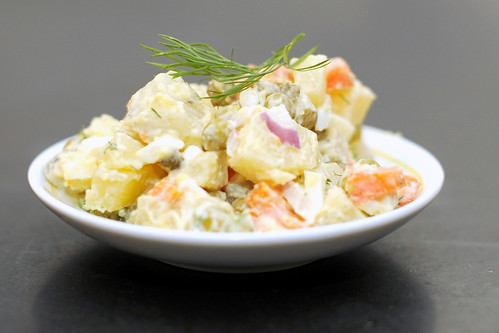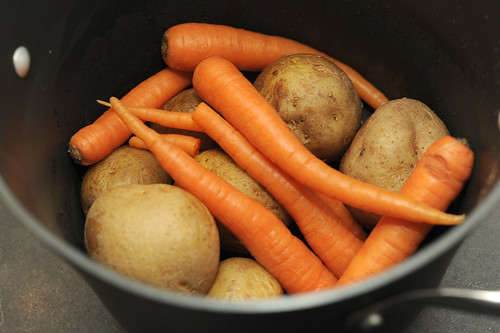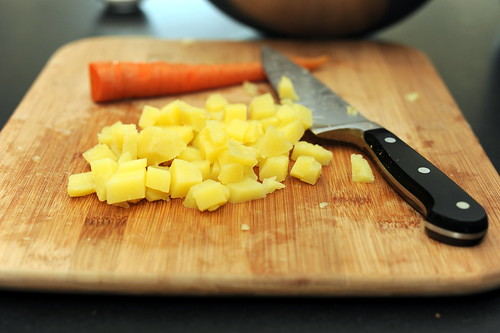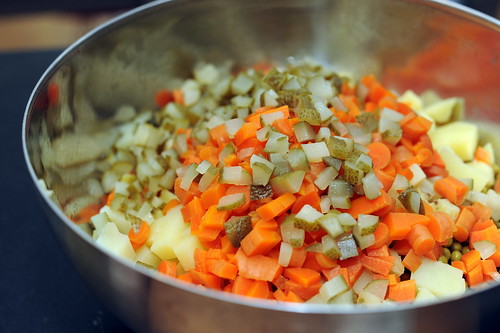salad olivier
This is the salad of my childhood, the salad present at every family gathering I can recall, the salad appearing at every Russian banquet table I’ve ever been to in America, the salad regularly lurking in many Russians’ refrigerators.
In my family, we’ve always referred to this salad as Olivier or Zimniy (“of winter”), but in America, sometimes I see this salad referred to as the Russian salad. And though Russians eat a lot of different salads, perhaps this one wins in the popularity contest department.
Back when I was growing up in Russia, fresh vegetables were simply not available in the winter. The vegetable store was semi-reliable with potatoes and over-wintered carrots, and whereas now I choose to eat mostly around the seasons, in Russia, we had no other choice. Herbs and cucumbers would appear in spring; berries and tomatoes were a summer event; and fall brought mushrooms, pumpkin and apples, to name a few. We had to make do with what we had, and my mother and grandmothers did a lot of pickling and preserving in the summer and fall months.
I remember our DIY pantry, which my dad built for my mom. It was in our hallway right by the entrance door. And it was always overflowing with pickles, jams, canned eggplant caviar, and other pantry sundries. But there was always something tasty at the table, something to feed a last minute guest or a large family gathering. And this humble salad was at every birthday, New Year’s celebration, anniversary. It’s seen a lot – it can tell you some stories. Like one about my fifth birthday – when my mother roasted a goose (my very first one) – and its aroma permeated the entire apartment. I was waiting for that goose all day, which if you recall being five years old, seemed more like an eternity than a matter of hours. We finally had the the bird, crispy and succulent, and then we, the kids, got bored of sitting at the table and decided to crawl under it and create mischief. Apparently, that was the day that one of my cousins buttered my dad’s knees. My dad, dressed in his finest suit, was not amused.
In any case, suffice to say that Olivier is as present at a Russian banquet table as a bottle of vodka. Curious about the history and origin of the dish, I went to the interwebs to find my answer. According to Wikipedia the first Olivier salad was served in the 1860s at the famed Hermitage restaurant in Moscow. Apparently, it was such a hit, people came to the restaurant for the salad alone. For that reason, I’m guessing, the salad was a closely guarded secret, but one employee tried to figure out the recipe and reverse engineer it when he left the restaurant to start his own. And while the ingredients are varied and numerous, we do know one of the many ingredients that the salad contained – grouse. Given our last grouse experience, I doubt I’ll be adding it to my version.
The current version of Olivier that you find in Russian restaurants and homes is what might be more appropriately called the “Soviet Olivier” – as exotic ingredients such as crayfish tails, grouse, and caviar became difficult to come by – the salad underwent the necessary modification to keep it from disappearing altogether. Exotic meats were replaced by ham or leftover chicken or bologna; gherkins – by regular pickles.
As kids we’d reach for it first, before salmon roe open-faced sandwiches, before the herring and onions, before the pickled cabbage. It wasn’t unusual for us to fight over the last few bits stuck to the side of the bowl.
And because this just might be Russia’s most popular salad, everyone makes this salad slightly differently, and everyone believes their version to be the best. All mayonnaise or half-mayo-half-sour cream dressing? Poached or roasted chicken, or Russian bologna (otherwise known as Doktorskaya kolbasa with its own fervent following). Anya von Bremzen in her excellent and encyclopedic (and sadly out-of-print – why?!?) Russian tome, “Please to the Table” uses cabbage for an amalgamation of slaw and potato salad together (intriguing!). Just about everyone insists on using canned peas. And almost everyone agrees that the salad tastes better the day after it’s made, when the flavors get an opportunity to mingle and get to know one another overnight.
Although, I once got admonished for using canned peas, (I remember when I wrote about vinegret, I got a disappointed email from a reader that I was using a canned good) I am sticking with it in this recipe because that’s how I have always eaten this salad. Sometimes I’d have it for breakfast, lunch, and dinner on the same day, only to do it all over again the following day. This was especially true when I was sick and my mother was desperate to get me to eat. When you are recreating the recipe of your early years, you’re not so much looking to make it the most high-brow recipe in the world. You’re feeding your nostalgia, your memories, your desire for simpler times. You’re going back in time and this salad is your time machine. I could use fresh or frozen peas, but that means I wouldn’t be traveling back. And for all of us, these trip are at times of the utmost importance. Whether it’s tapping into a memory for yourself or sharing it with those you love.
For me, Olivier was the security blanket of comfort meals – always reliable, tremendously filling, brightly accented by the briny bits of pickle. And it is this salad that I am now sharing with you – in all its canned-pea-Russian-bologna-mayonnaised glory. Won’t you have some?
Salad Olivier
Ingredients:
3 pounds Yukon gold potatoes (you can use other potatoes, but I like these best) boiled, peeled, and cut into small cubes (you can cook the carrots and potatoes together)
1/2 pound carrots, boiled, peeled, and cut into small cubes
4 large hard-boiled eggs, cooled, peeled, and cubed
1 can green peas, rinsed and drained
4-5 sour kosher dill pickles (this is important, as while regular kosher dill pickles will work, they are not the same intensity as the sour ones, which are saltier and brinier – as opposed to more vinegary)
1 cup finely diced bologna (about 1/4 pound), or shredded chicken, or diced ham (or purely optional)
1/3 – 1/2 cup mayonnaise (or half mayo, half sour cream)
3 teaspoons chopped dill (optional)
Salt, to taste
Preparation:
1. In a large bowl, combine together the potatoes, the carrots, eggs, peas, pickled and bologna, if using, being careful not to mash the ingredients.
2. Add the mayonnaise (or the mayo-sour cream mixture) and the dill, if using, and toss with the salad ingredients until well incorporated. Taste and add salt, if necessary – the deli pickles are pretty salty, so taste before adding salt to the salad. Refrigerate until ready to serve. Salad should keep 3-4 days.
Serves 8.




Juanita
Feeding one’s nostalgia for childhood can be a very tasty thing on so many levels.
ilya
You forgot to mention the onions :) – which could be skipped, of course, but some people (including yourself, it seems, judging by the photo) do use.
Radish
Ilya – good point. Normally, I do skip them and didn’t like them in the salad. Did that to prevent a little piece of the onion from going bad.
Lyubasha
Thanks so much for the memories! My family usually called Olivier “myasnoi salat” and we used beef for the meat. A piece of beef would be boiled, creating some beef broth, and the meat would go into Olivier. I think sometimes we would skip the carrots too, but definitely potatoes, pickles, canned peas and mayo!
Errin
Some recipes REQUIRE you to use the exact same ingredients that previous generations used…I will be trying this recipe…canned peas and all :) . If it has been approved by several generations then why would anyone mess with success and swap out the canned for fresh? Thanks for sharing!
Molly
My best friend growing up was from Riga, Latvia, so I have enjoyed this salad many, many times. I absolutely love it but have never made it myself. Thank you for the recipe and thank you for reminding me that I really owe her a phone call.
And I agree, canned peas are the only way to go with this dish.
Ruth
I love this kind of salad – there’s something so homely and unpretentious about it. I remember having similar salads when I lived in Germany, but they often contained celeriac too. I might have to try this version when I’m feeling nostalgic!
Lena
My grandma makes ours with imitation crab meat, I have no idea how this started but its is delish! My favorite variety by far ;) (and no carrots or pickles in ours .. I know, super weird!)
Great post as always lady!
yossy
yum! my iranian family makes the same dish and calls it the same thing!
Dana
What an interesting looking salad! I don’t know that I could move myself to use canned peas (no nose turning to canned goods, canned peas and I just aren’t good friends), but if they make a big difference maybe it would be worth trying.
Christine
I love this salad! And thank you for the reminder about Please to the Table. I have a copy floating about somewhere in my parents’ house
Brian @ A Thought For Food
I think everyone has that salad that they grew up with and are always nostalgic for. This one is so beautiful and simple and has inspired me to revisit one of my childhood favorites. Will be posting that soon :-)
-Brian
Jen
Ensalada rusa! I first had this salad in Spain, and my potato-mayonnaise-loving self couldn’t get enough. I found it hysterical that that’s what they called it, not knowing the real origins back in college. My version uses capers instead of pickles, but I’m going to give pickles a try next time.
noëlle {simmer down!}
@Jen- Hah- I’ve never had this in the States but it was common in France where it was also called Salade Russe. Funny.
Melissa from Traveler’s Lunchbox mentioned Please to the Table recently as well. I think this is a sign I need to hunt down a used copy or at least get it from a library to check out.
Amber
I made this salad two days a go and the husband and I have enjoyed it everyday! I put lots of ham and pickles in it, which just made our day.
I made about a half batch but I didn’t really measure anything. My favorite part about this salad?…It is a balanced, satisfying meal all by itself! But I can’t wait to take it to a pot-luck to share with others. :)
Oh, I had to use frozen peas this time because the store I went to didn’t carry canned peas (Trader Joe’s), but I will use them next time. :P
I sincerely thank you for this recipe.
Josephine S.
very interesting! this is an iranian classic as well,
Salad-o-Olivieh
the only difference is chicken instead of bologna
George In Canada
The fights here are about whether or not you put in pickles.
Try it with a vinaigrette instead of mayonaise, a nice change.
Nina
Yes, surprisingly, the absolute best Oliviers in New York, I tried not on Brighton but at fancy Iranian restaurants…
Radish
Nina – now I must find a fancy Iranian restaurant and go check it out. I worry though that I’ll still think my mom’s is the best, being guided by childhood memories :-) But I love trying different versions.
2012 | Sassy Radish
[…] Salad Olivier […]
Simona
About 21 years ago, when we first moved to LA, we had a NY party at my friend’s house. I was responsible for 1 dish, Olivier. The day of the party my grandma mentioned that she had just made plenty of this salad for the party she was going to and I could simply take some of it with me. During the party when everyone was happily eating, the hostess asked whose idea it was to add apples to the Olivier salad. I had no idea that apples even go into this salad. Apparently, my grandma has decided to use a new recipe from one of her new friends from Moscow. There was a whole debate that night at our NY table whether apples should be included in this salad. Who knew? Btw, since that day my grandma has never experimented again with the recipe. In Moldova, where we’re from, apples were never a part of the salad. P.S. I just discovered your blog! Great job!
Radish
Simona – hysterical. No, I’ve never heard of apples in Olivier either. My mom, sometimes, tries to put a spin on the old favorites and my dad and I throw a fit every time. We like our predictable nostalgia-filled dishes just as we remember them!
Irene
I keep thinking about the pickles that you describe above, and something just does not sound right to me. The only pickles that are the same as the ones we had in the USSR are Israeli pickles (Osem is one of the brands), and they can be found in a lot of Russian stores and in local supermarkets in the Jewish/kosher section. None of the American brands of pickles are pickled in brine, and they just don’t give this salad its authentic Russian taste.
Small comment about otherwise excellent recipe!
Radish
Irene – we’ve found them in our supermarkets here in the Northeast – -usually it’s a Polish brand or something similar, but I think, ultimately, the choice of the pickle is really up to you. My mom likes the dill pickles, while I am staunchly in the brine/deli/salty pickle (the one we used to make rassolnik with) category. But Osem pickles are, indeed, outstanding!!
Alina
My family always tells a different legend about the origin of Olivier,and it’s rather amusing. A French aristocrat had a huge party, the kind a party that no one leaves. In the morning, with tons of people to feed he simply looked through his pantry and threw everything in a bowl, mixing it with mayo. The aristocrat’s name? Oliver!
olga
Alina – I love that story!! I think, though, there’s some historical reference as to it being the most famous salad in imperial Moscow at some point and MUCH more decadent than our Soviet version. I read something about it once, but need to go and find it.. This is, however, sort of how Caesar salad was created in Tijuana during the Prohibition era – a panicked chef with hungover guests and a near empty pantry!
Spicy Grilled Beef-Grape Salad by Chef Vichit Mukura of Sala Rim NaamSheSimmers
[…] They’re typically not the cold salads that are/can be marinated and/or refrigerated (think Russian Salad Olivier, French-style celery root remoulade, or American-style potato salad). I would also add to his […]
Food Festival | soodabehhashemi
[…] or a fancy lunch.it is quiet well-known in Europe but has definitely different variations. This recipe is the original french one I […]